Chicago ''L''.org: Operations - Lines - (original) (raw)
| 
 | |
| ------------------------------------------------------------------------------------------------- | |
| |
| ------------------------------------------------------------------------------------------------- | |
 |
 |
|---|
.
Green Line: South Side Elevated
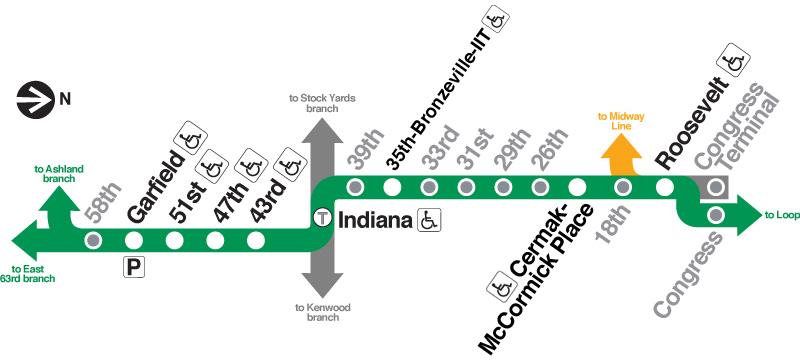 |
|---|
Legend:  Current Line w/Station .. Current Line w/Station ..  Accessible Station Accessible Station  Current Line w/Former Station .. Current Line w/Former Station ..  Park'n'Ride lot Park'n'Ride lot  Current Line w/Former Transfer Station Current Line w/Former Transfer Station  Demolished Line w/Former Station .. Click on a station name to see that station's profile (where available) Demolished Line w/Former Station .. Click on a station name to see that station's profile (where available) |
Service Notes:
Hours of Operation: 4am-1am, Mon-Fri; 5:15am-1am, Sat; 5:50am-1am, Sun Length of Route: 6.5 miles Number of Stations: 8 stations Car Types Assigned: 5000-series(see Car Assignment sheet for latest car assignments)
Brief Description:
The Green Line was created in 1993 when the Lake Line was linked with the Englewood-Jackson Park Line via the Loop elevated. Previously, the Howard Line had been linked with the Englewood-Jackson Park Line via the State Street Subway and the Dan Ryan had been through-routed with the Lake Street Line via the elevated and the Loop.
The South Side main line represents the oldest section of the "L" in the city, with the portion between Congress Street and Pershing (39th Street) completed in 1892. To serve the Colombian Exposition of 1893, the Alley "L" (the South Side's nickname at the time) began making plans to extend its line directly into the fairgrounds. In 1893, an extension opened between 39th Street and the fair near 64th and Hayes via the alleys and East 63rd Street. In 1905, a new branch opened. Leaving the main line at about 59th Street, the Englewood Branch wound its way to West 63rd Street, then west to a terminal at Loomis Street, extended a few blocks to Ashland Avenue in 1969. These lines were built as typical elevated steel trestles, mostly over alleys and private right-of-way, except for the Jackson Park Branch, which runs over East 63rd Street.
In 1993, the Green Line was formed when the Lake Street and Englewood-Jackson Park Lines were through-routed. With both halves of the new line made up of the two oldest sections of the "L", the structure was beginning to show the ravages of time. Early the next year, the Green Line was closed for an extensive renovation project lasting more than 2 years. A great deal of controversy raged during the two year rehab, including debates over station closings, retention of nighttime "owl" service and the date of reopening. On May 12, 1996, the Green Line reopened. Owl service is retained (only to be dropped a year later), but the line reopened with fewer stations: Homan, Halsted,58th, 61st, Racineand University were closed. Jackson Park trains began to terminate at Cottage Grove Avenue (East 63rd) while the future of the elevated segment east of there to Dorchesterremained undecided. On September 27, 1997, the CTA reached a decision on the fate of the Cottage Grove-Dorchster segment of the Green Line: with less then 24 hours of public notice, city workers moved in and dismantled the "L" line.
Also upon reopening, the branches were renamed from Englewood to Ashland and from Jackson Park to East 63rd to be more specific and to correlate with the new train signage, although many longtime riders still use the original names.
The Green Line has a larger proportion of handicap accessible stations than any other line (tied with the Orange Line). This occurred during the 1994-96 rehab. Due to the large amount of work done at many stations, federal law required the CTA to make many of the stations ADA compliant during the project.
Important Dates:
- January 4, 1888 - The Chicago and South Side Rapid Transit Company is incorporated under the general railroad laws of the State of Illinois.
. - March 26, 1888 - The city aldermen approve a franchise for the SSRT allowing it to build an elevated railroad starting at an unspecified location between Wabash and Dearborn from the north line of Van Buren Street south to 39th Street (the then-city limits). Mayor Roche adds his signature a few days later. The franchise is good for 50 years and allowed uniformed police and firemen to ride free (a practice that continues on the CTA today).
. - November 1890 - An international committee chooses Jackson Park as the site of the 1893 World's Fair. Not wishing to miss out on the potential ridership from this area which they intended to ultimately serve anyway, the SSRT begins making plans to extend from 39th Street to Jackson Park. Early reports indicated that the SSRT wanted to run over East 63rd Street to reach the grounds (which would have required property owner consent), but the company instead requested the use private property. The aldermen approve a route south from 39th to a point between 40th and 43rd Streets, east to a point east of Indiana Avenue, south to between 60th and 67th Streets, then east to Jackson Park. Two branch lines were also approved: a never-built line extending south from 63rd to 71st Street between South Park [King Drive] and Cottage Grove Avenues; and a branch leaving the main line between 55th and 59th Streets, heading west to a point between Wentworth and Wallace Avenues, then south to terminate at 63rd Street [this would become the Englewood branch].
. - May 27, 1892 - The first train carrying passengers over the SSRT operates. A 6-car train carrying 300 guests of the company makes an inspection run before the inauguration of regular passenger service.
. - June 6, 1892 - Revenue passenger service begins between Congress Street terminal and 39th Street.
. - August 14, 1892 - Service is extended south to 47th Street. Service is continually extended south as the structure is completed. Extensions to 51st, then 55th Street soon follow.
. - January 22, 1893 - The structure is completed to 63rd Street, allowing service as far south as 61st Street station.
. - October 18, 1897 - Following the completion of the Union Loop elevated structure, South Side trains are diverted from the Congress Street Stub to the Loop elevated line. The South Side would be the only company to run steam trains over the Loop, operating on the Inner Loop in a counterclockwise direction. Concurrent with the opening of the Loop, the Congress Stub is deactivated.
. - July 27, 1898 - The conversion to electric traction on the South Side Elevated is complete and all steam locomotives are withdrawn from service.
. - March 10, 1902 - Due to congestion on the Loop elevated, the Congress Street terminal is reopened for certain rush hour trains. To distinguish it from the new Congress/Wabash station a 1/2 block east, the stub terminal is referred to as "Old Congress". Information indicates that it may have only been served by Englewood trains by 1913.
. - March 16, 1903 - City permission is given to add a third express track between 12th Street and 43rd Street. The track is placed above the adjacent alley and as part of the agreement, the South Side Elevated must pave the alley below and replace their station houses with mezzanine facilities that allow cars to pass beneath. On the same date, a 35-year franchise is given to the Englewood Elevated Railroad Company (who was controlled by the South Side Elevated) to build a main line that would leave the South Side between 55th and 60th Streets, turn west to between Wentworth and Wallace Avenues, turn south to a point between 61st and 67th Avenues, then turn south and terminate between Racine and Ashland Avenues [the Englewood branch]; as well as a branch line leaving the above and paralleling Wentworth Avenue to a point between 68th and 72nd Streets [the Normal Park branch].
. - May 14, 1903 - A preliminary agreement is reached with the Chicago Junction Railroad to allow the South Side Elevated to construct branches to the Union Stock Yards and Kenwood neighborhood along their existing right-of-way. The work would be done in conjunction with the elevation of the Junction Railway's tracks, which had been required by a city council ordinance.
. - September 30, 1903 - A 50-year lease is signed between the South Side Elevated and the Chicago Junction Railway with an option for two 50-year renewals and an option to buy.
. - September 20, 1907 - Delayed by problems elevating the adjacent Chicago Junction Railway tracks and in construction of the transit facilities, the Kenwood branch opens between 42nd Place and Oakenwald and Indiana Avenue station. Base service consists of 42nd-Indiana shuttles alternating with 42nd-Loop locals. Express service to the Loop is operated at peak times.
. - April 8, 1908 - The Stock Yards branch opens. The line leaves the main line at Indiana Avenue and proceeds in a basically westerly direction before terminating in a one-track loop around the Packingtown area of the Stock Yards. It is reported that 25,000 persons, mostly curiosity seekers, ride the first day.
. - November 3, 1913 - Crosstown "L" service is first initiated, with trains running from Linden Avenue in Wilmette to the Stony Island Avenue terminal in Chicago's Jackson Park. The South Side and Northwestern trains operate on the outer track in a counterclockwise direction (actually only running over two sides of the Loop on each crosstown trip). Crosstown pairings include Evanston-Jackson Park, Wilson-Englewood, and Wilson-South Park runs (the last being believed to be very short-lived).
. - July 31, 1949 - The CTA institutes its massive North-South service revision. Service is streamlined into the following routes: Howard-Englewood, Howard-Jackson Park, Ravenswood (Kimball-Loop), and Evanston (Linden-Howard during non-rush hours, Linden-Loop during rush). A/B skip stop service is instituted on the Howard, Englewood, Jackson Park and Ravenswood routes, and 23 low-use stations are closed, including Roosevelt, 18th, 26th, 29th, 31st, 33rd, Pershing, and Congress Street stub terminal.
. - September 28, 1969 - Service begins in median strip of Dan Ryan Expressway. The Lake Street line is routed through to Dan Ryan line via Loop elevated and the old Loop-South Side connector, abandoned in 1949.
. - January 9, 1994 - The Lake-Englewood-Jackson Park Green Line closes for an extensive renovation project lasting more than 2 years. A great deal of controversy raged during the two year rehab, including debates over station closings, retention of nighttime "owl" service and the date of reopening.
. - May 12, 1996 - The Green Line reopens after a renovation project lasting more than 2 years. Owl service is retained, but Racine/63 is closed. Englewood branch is officially renamed the Ashland branch.
. - April 27, 1998 - The CTA institutes some of the largest service cuts in its history. Under the Booz-Allen Hamilton Service Plan. Owl Service is cut on the Green Line.
. - February 8, 2015 - New Cermak-McCormick Place station opens.
| This Chicago-L.org article is a stub. It will be expanded in the future as resources allow. |
|---|

South Side Elevated | Harrison Curve
South Side Elevated
 |
SSRTwoods@43rdSt.jpg (79k) A southbound train on the South Side main line is slowing down while approaching 43rd Street station in early 1907. The line narrows from three tracks (the center express track having just been installed at this time) and two here, just before entering the station. (Photo from the LeRoy Blommaert Collection) |
|---|---|
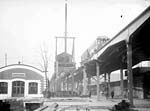 |
ROW_construction02.jpg(93k) A two-car South Side Elevated train heads east at Michigan and 40th, with men kneeling on the structure near the train, in 1908. On the right is the South Side main line, built in 1892, with it's special design for park boulevard crossings as it goes over Michigan Avenue. On the left, the Stock Yards branch is still under construction, the large hoist's work nearly complete as the structure is only a block away from the branch's Indiana Avenue terminal. (Image #DN-0005794, Chicago Daily News negatives collection, Chicago Historical Society Collection) |
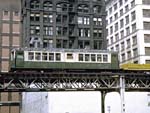 |
cta4215b.jpg(50k) With the arrival of the 2000s, the Baldie 4000s were retired quickly. Most were scrapped in 1964 and '65, but a few stuck around for a while. Although car 4215 did not formally become a work motor (i.e. it was not assigned an "S" car number), it was used in nonrevenue service for a few years. In this May 1969 view, it's south of theLoop over Wabash Avenue hauling a flat car as part of the preparation for return of this line to revenue service when the Dan Ryan line opened later in the year. Car 4215 was retired the next year, in 1970. (Photo by Jerry Appleman) |
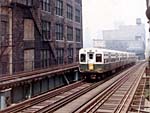 |
cta6000s@16th.jpg (309k) A North-South train of 6000s on its way to Loomis/63 nears the top of the incline from the 13th Street portal in June 1968. The Englewood-Howard All-Stop train is bearing a "Baseball Today" sign, meaning a game is on at one of the two ballparks served by the route. The shot is taken from a fantrip train heading north on the South Side Elevated to the Loop. At the time, the incline from the subway was in regular use by North-South trains, while the track the fantrip train was on was used only for special movements; today the situation is reversed. (Photo by Leon Kay) |
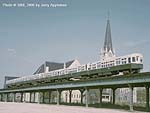 |
cta6000s10.jpg (51k) A train of CTA 6000-6200 series cars run on a southbound six car Englewood-Howard "A" train at 30th Street on the South Side mainline in October 1968. (Photo by Jerry Appleman) |
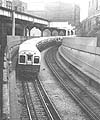 |
cta6000s@13th.jpg (104k) Between 1943 and 1993, northbound trains heading for the State Street Subway on the North-South Route left the old South Side elevated near 15th Street to enter the subway at the 13th Street Portal. Two 6000-series trains, including a Howard-bound "A" train (foreground), are seen here at the portal circa the 1970s. The tracks in the background, also part of the old South Side elevated, were used by Lake-Dan Ryan trains at the time of the photo, from 1969 to 1993. (Photo by Brian J. Cudhay) |
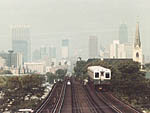 |
cta6684.jpg (95k) A Jackson Park train with 6684 on the rear end has left 35th Street station and is heading northbound up the roller-coaster south side main line. (Photo by Michael Roegner) |
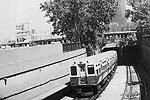 |
cta6717.jpg (114k) A black and white shot of 6717 emerging from the 13th Street portal in 1985. (Photo by Leon Kay) |
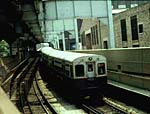 |
cta6500.jpg (56k) Car 6500 picks up the rear on this 6000-series train climbing to the South Side "L" structure from the State Street Subway on May 25, 1986. (Photo by Leon Kay) |
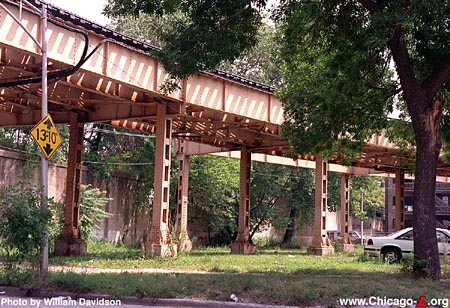 |
ROW@Prairie.jpg (451k) Just east of Prairie Avenue, the Kenwood branch split off from the South Side Main Line. The main line (now the Green Line) curves to the right here as we look east, while the Kenwood continued straight for a short distance before descending onto the embankment on the left. (Photo by William Davidson) |
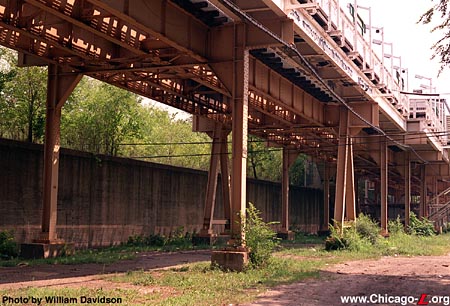 |
ROW@Indiana_station.jpg (363k) The elevated structure through Indiana station was largely rebuilt between 1988 (when Indiana station's platform were rebuilt) and 1996 (when the Green Line rehab was completed), hence relatively little of the 1890s structure remains here. The embankment on the left carried the Chicago Junction freight tracks.(Photo by William Davidson) |
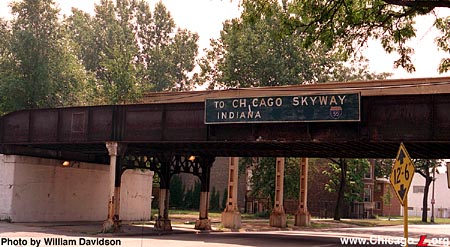 |
ROW@Michigan01.jpg (355k) Looking south along Michigan Avenue, one of the south side boulevards. The street was a major north-south thorough fare leading to, among other things, the Chicago Skyway, one of the first expressways built in the city in the 1950s (hence the very old sign on the bridge). (Photo by William Davidson) |
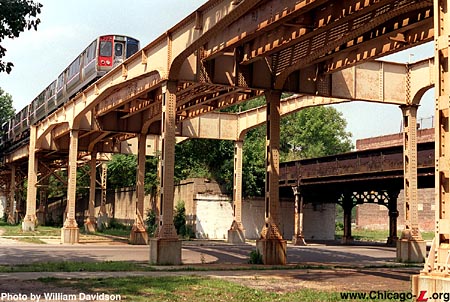 |
ROW@Michigan02.jpg (406k) Looking northwest at the structure of the South Side Elevated as it crosses Michigan Avenue, as an East 63rd Branch Green Line train passes overhead. The structure takes on a somewhat more graceful appearance here because it is crossing part of the city's park boulevard system, an aesthetic requirement from the South Park Commission. (Photo by William Davidson) |
 |
cta2515.jpg(79k) Car 2515, assigned to the Green Line, makes its way through the canyon of former and current industrial buildings in the South Loop as it makes it way to the Loop and Harlem/Lake after leaving Roosevelt station circa 1993. Despite the use of the "Loop" destination sign, this train is probably not being short-turned. For a short time, operators were ordered to use "Loop" destination signs on their way to the Loop, then change to the terminal specific sign for use within the Loop and beyond. This practice was quickly discontinued as it proved to be confusing to riders and too much work for motormen. (Photo by Eric Oszustowicz) |
Harrison Curve
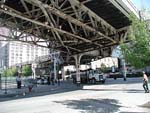 |
ROW@HarrisonCurve02.jpg(243k) Looking northeast at one of the tight turns of Harrison Curve over the corner of Harrison and Wabash on September 30, 2002 as a southbound Green Line train enters the curve.(Photo by Graham Garfield) |
|---|---|
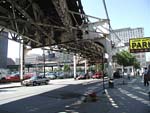 |
ROW@HarrisonCurve03.jpg(207k) Harrison Curve on September 30, 2002. (Photo by Graham Garfield) |
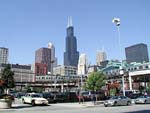 |
ROW@HarrisonCurve04.jpg(178k) Harrison Curve on September 30, 2002. (Photo by Graham Garfield) |
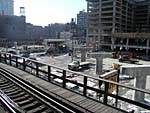 |
ROW@HarrisonCurve05.jpg(225k) On February 26, 2003, the new concrete columns -- similar in design to most new "L" construction -- are in place along the new alignment. (Photo by Graham Garfield) |
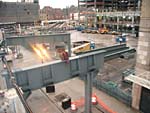 |
ROW@HarrisonCurve06.jpg(140k) This view looking southwest from the South Side Elevated, north of Harrison Curve, on March 4, 2003 shows the new steel bents that will connect the existing structure to the new curve and the path the new alignment will take.(Photo by Graham Garfield) |
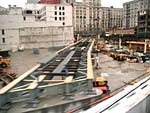 |
ROW@HarrisonCurve07.jpg(161k) By March 4, 2003, all the steel spans were in place on the new curve and some ties and grated walkway sections had even been put in place, as seen looking northeast from the existing Harrison Curve. (Photo by Graham Garfield) |
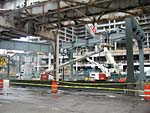 |
ROW@HarrisonCurve08.jpg(225k) The current 1897-vintage steel elevated structure is steel alongside its eventual replacement, looking northwest on Wabash on March 8, 2003, showing where the right-of-way will curve off into the new alignment. (Photo by Graham Garfield) |
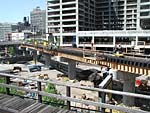 |
ROW@HarrisonCurve11.jpg(225k) The new Harrison Curve structure, seen looking west from the current realignment, is almost totally complete on May 20, 2003, including its cantilevered platforms for signals and equipment. The place where the new structure will connect to the old at the south end is seen in the background. To see how quickly the work was completed, compare with the near-exact same view only four months before, on February 26th by clicking here.(Photo by Graham Garfield) |
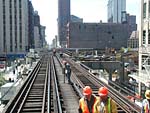 |
ROW@HarrisonCurve12.jpg(225k) Construction personnel are hard at work on May 20, 2003 to make the final preparations and checks before the big changeover on the weekend of May 23-27. The location where the north end of the new structure will connect to the old alignment over Wabash is evident. After this weekend, the structure in the background will be taken out of service for demolition. (Photo by Graham Garfield) |
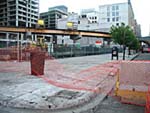 |
ROW@HarrisonCurve14.jpg(250k) Holes and fractured sections of sidewalk where the footings had been previously, like the one in the foreground, are all that was left to betray the presence of the old Harrison Curve only days before in this May 26, 2003 view looking northwest at the new alignment in the background.(Photo by Graham Garfield) |
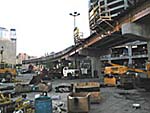 |
ROW@HarrisonCurve16.jpg(152k) On May 27, 2003, the new Harrison Curve was in service, as seen in this view looking southwest as an outbound Green Line train traverses the new alignment. Although most of the fabrication work was done, the materials and equipment still laying around reveal that not all the work, including cleanup, had been completed. (Photo by Graham Garfield) |
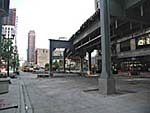 |
ROW@HarrisonCurve17.jpg(131k) During the previous three days, this entire new section over Wabash connecting the new curve with the old alignment -- footings, bents, spans, and all -- were erected from scratch and is seen looking south on its first day in service on May 27, 2003. (Photo by Graham Garfield) |
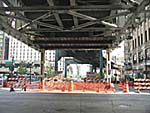 |
ROW@HarrisonCurve18.jpg(181k) Looking south on Wabash from Congress Parkway on May 27, 2003, the clean steel and gentler sweep of the new alignment stand in contrast to the older, preexisting elevated structure. The street is still closed because much work still needs to be completed before Wabash can reopen.(Photo by Graham Garfield) |
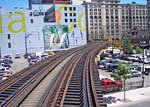 |
ROW@HarrisonCurve19.jpg New Harrison Curve on June 19, 2006. (Photo by William Davidson) |
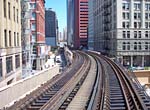 |
ROW@HarrisonCurve20.jpg New Harrison Curve on J une 19, 2006. (Photo by William Davidson) |
| . Unusual Train Operations During Construction | |
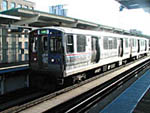 |
cta2495.jpg(202k) During the three days that Harrison Curve was closed for reconstruction, inbound Green Line trains on the Lake branch were short-turned on the Outer Loop and displayed "Loop" destination signs and markers on their way east, as seen on car 2495 stopped at Clinton on May 26, 2003. (Photo by Graham Garfield) |
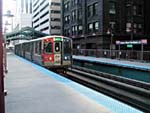 |
cta2523.jpg(179k) A Green Line train at Library station?! It happened over Memorial Day weekend 2003, when Green Line trains from Harlem were short-turned on the Outer Loop due to the reconstruction of Harrison Curve. Here, car 2523 leads a Green Line train pulling into Library on May 26, 2003. (Photo by Graham Garfield) |
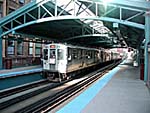 |
cta3378.jpg(205k) While Orange Line was truncated at Roosevelt over Memorial Day weekend 2003 due to Harrison Curve reconstruction, there would've been no service on the Inner Loop. To compensate for this and aid in circulation of passengers around the Loop, a shuttle was operated all weekend with Orange Line equipment, as seen on Library on May 26, 2003, with car 3378 leading the 4-car consist. To see a close-up of the sign on the chains, click here.(Photo by Graham Garfield) |
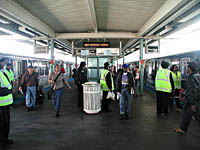 |
roosevelt-wabash05.jpg (171k) During the shutdown of Harrison Curve over Memorial Day 2003, Roosevelt/Wabash served as a stub terminal for northbound Orange and Green line trains. The squad of vested operating personnel, along with the paper signs on the backlit sign, help passengers find their way in this view on May 26, 2003. (Photo by Graham Garfield) |


- CTA Straightens Out System
- Date of Publication: May 20, 2003
- Source: Medill News Service
- Editor's Note: This site and its administrator are mentioned and quoted in this article!
.
 |
 |
|---|